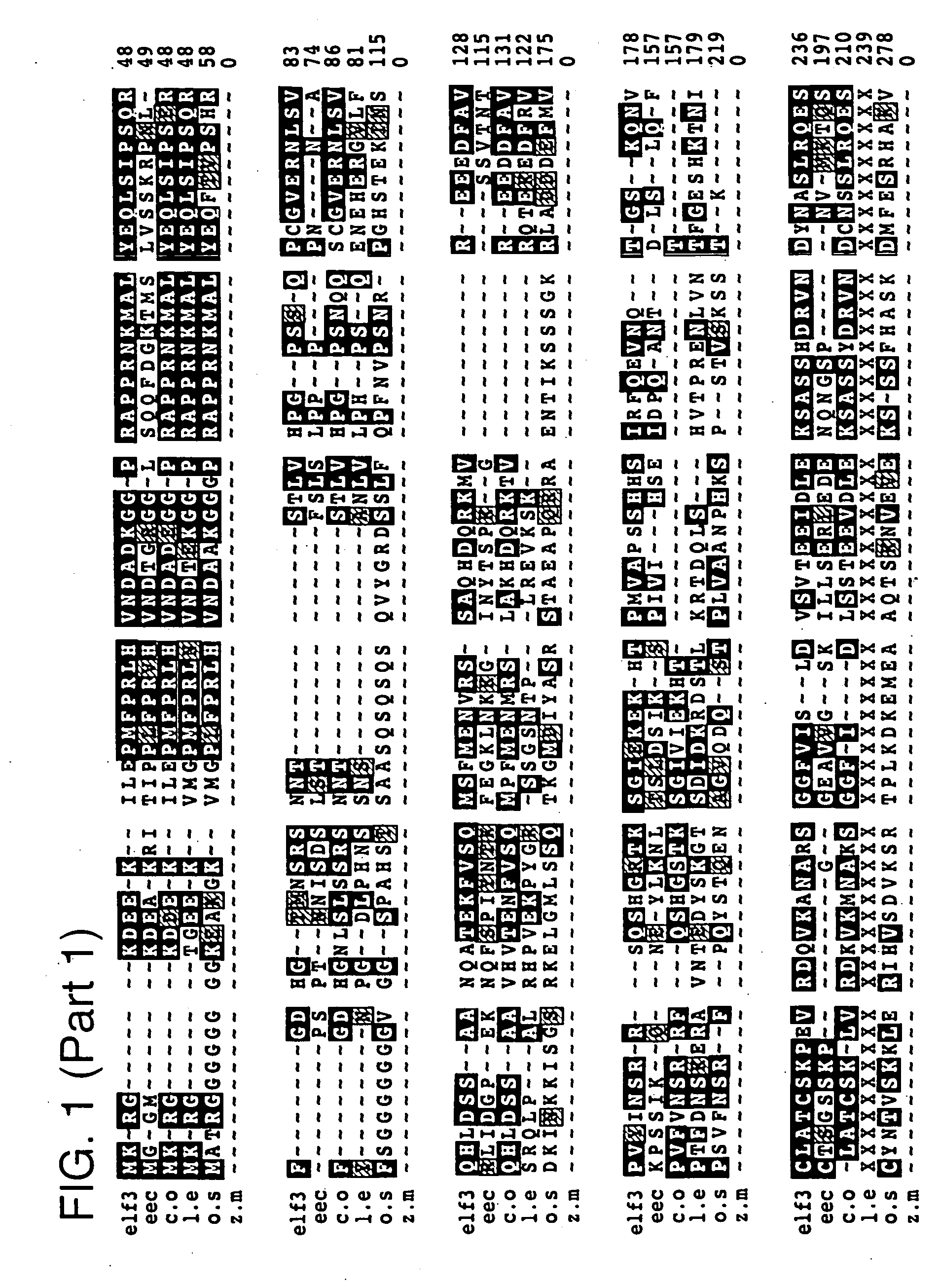Genes regulating circadian clock functional and photoperiodism
a technology of circadian clock and gene, applied in the field of genes, can solve the problem of little information on the molecular mechanisms that directly regulate the developmental pathway
- Summary
- Abstract
- Description
- Claims
- Application Information
AI Technical Summary
Benefits of technology
Problems solved by technology
Method used
Image
Examples
example 1
Cloning Arabidopsis ELF3
[0184] The ELF3 gene was isolated by map-based positional cloning. Molecular markers tightly linked to the ELF3 gene were identified by random fragment length polymorphism (RFLP) analysis, and a high resolution genetic map of the locus was constructed. The region containing the ELF3 gene was narrowed down to 30 kb contained on a single bacterial artificial chromosome (BAC). This BAC was sequenced, and cDNAs with homology to sequences within the BAC were isolated from a variety of cDNA libraries. The ELF3 sequence was further localized by complementation experiments to a 10 kb subcloned fragment contained within the BAC. Identification of the appropriate gene within the subcloned fragment was confirmed through isolation and sequencing of elf3 alleles from various Arabidopsis elf3 mutants.
[0185] The isolated ELF3 gene (SEQ ID NO: 3) has no significant sequence similarity to other DNA or protein sequences with assigned function. However, a published EST (GenBa...
example 2
Analysis of ELF3 Phenotype
[0187] Sensitive assays for monitoring circadian rhythm responses in Arabidopsis have been developed (Millar and Kay, 1991; Millar et al., 1992). One assay system is based on the observation that the transcription of the chlorophyll a / b binding protein gene, CAB2, cycles on a 24-hour period. Transcription from the CAB2 promoter increases prior to subjective dawn, peaks in late morning, and falls to a low level late in the day (Millar and Kay, 1991). Cycling of CAB mRNA continues under constant light conditions. In order to follow expression in vivo, the CAB2 promoter has been fused to the gene encoding firefly luciferase (luc), and this fusion has been transformed in wild-type Arabidopsis (Millar et al., 1992). Transcriptional expression from the CAB2-luc fusion construct is monitored by imaging single transgenic seedlings using a low-light video camera and a photon-counting image processor; the results from imaging the CAB2-luc fusion is comparable to the...
example 3
Introducing ELF3 Sequences into Plants
[0190] Plasmid Construction
[0191]Arabidopsis ELF3 cDNA (SEQ ID NO: 1) and full-length genomic (SEQ ID NO: 3) sequences were used in the construction of over-expression and antisense vectors. These sequences were operably linked to the CaMV 35S (constitutive) promoter, in both the sense and antisense orientations, and cloned using standard molecular biology techniques into pSJL4 (Jones et al. 1992).
[0192] The over-expression and antisense expression cassettes were removed from the above vectors and inserted into pMON5O5 for Agrobacterium-mediated plant transformation.
[0193] Plant Transformation
[0194] Wild-type and elf3 mutant Arabidopsis plants (ecotype Columbia) were transformed using standard in planta Agrobacterium-mediated techniques (Chang et al. 1994, Katavic et al. 1994). Transformed seeds were selected on kanamycin, and KanR seedlings transferred to soil and grown for further analysis.
[0195] Over-expression of ELF3 protein in elf3 m...
PUM
| Property | Measurement | Unit |
|---|---|---|
| Tm | aaaaa | aaaaa |
| temperature | aaaaa | aaaaa |
| length | aaaaa | aaaaa |
Abstract
Description
Claims
Application Information
 Login to View More
Login to View More - R&D
- Intellectual Property
- Life Sciences
- Materials
- Tech Scout
- Unparalleled Data Quality
- Higher Quality Content
- 60% Fewer Hallucinations
Browse by: Latest US Patents, China's latest patents, Technical Efficacy Thesaurus, Application Domain, Technology Topic, Popular Technical Reports.
© 2025 PatSnap. All rights reserved.Legal|Privacy policy|Modern Slavery Act Transparency Statement|Sitemap|About US| Contact US: help@patsnap.com



